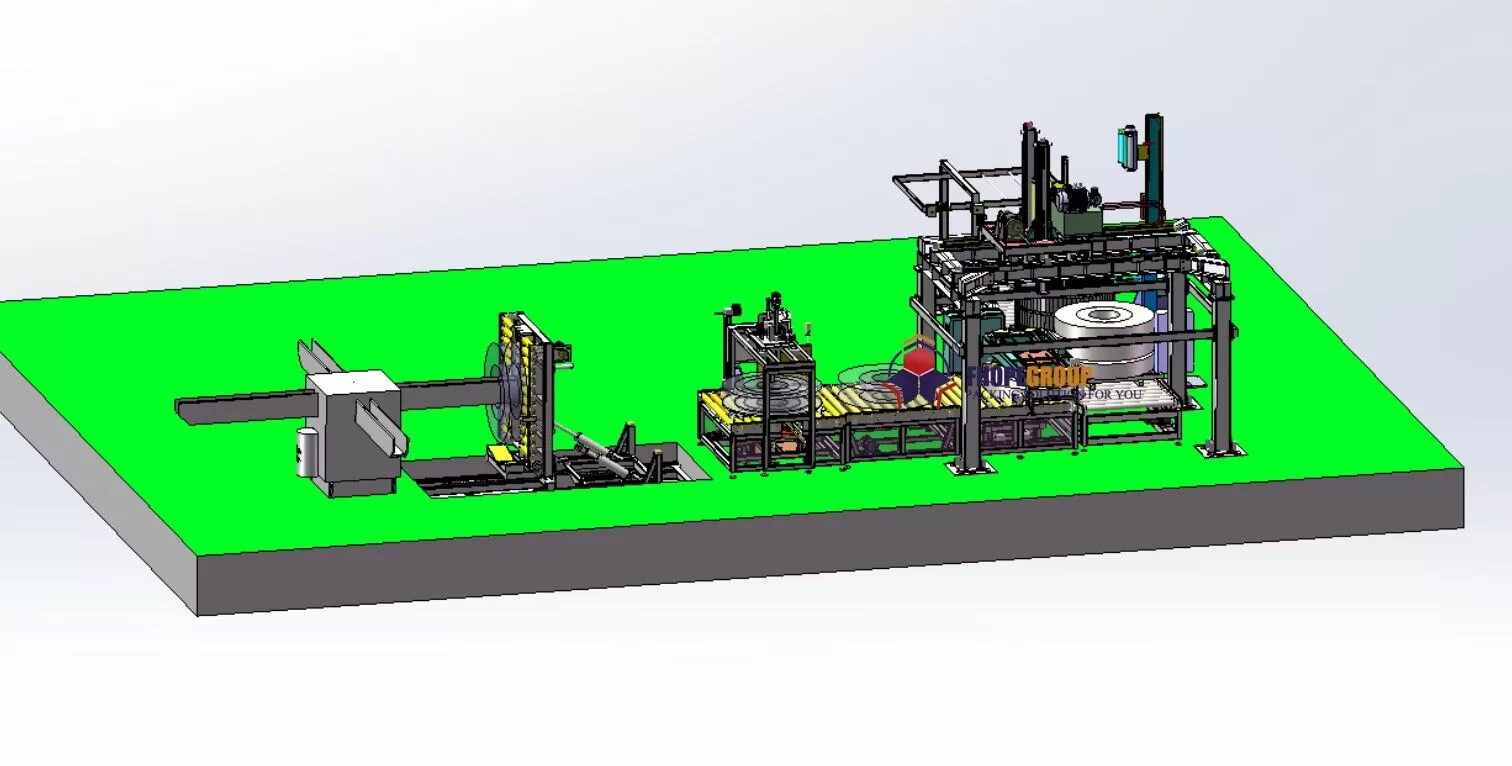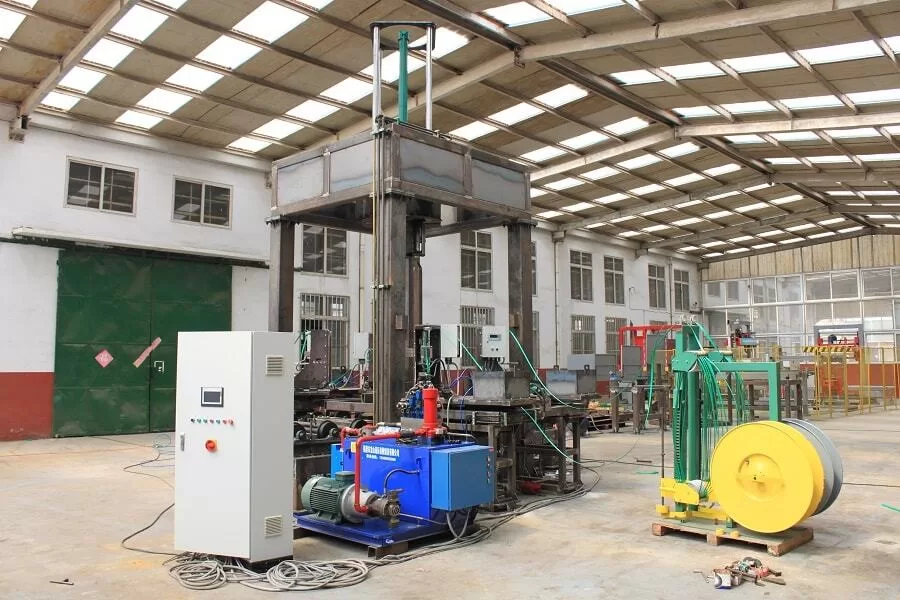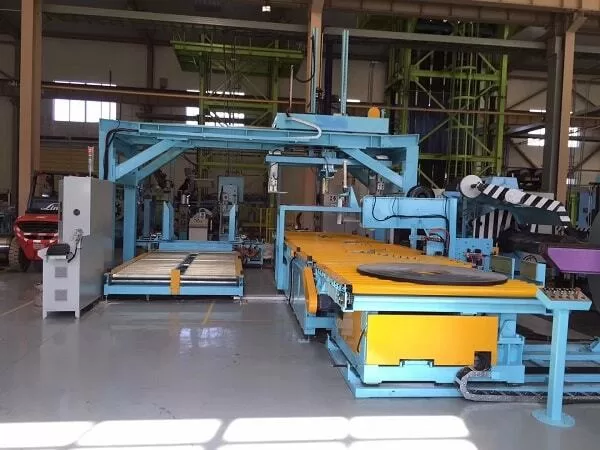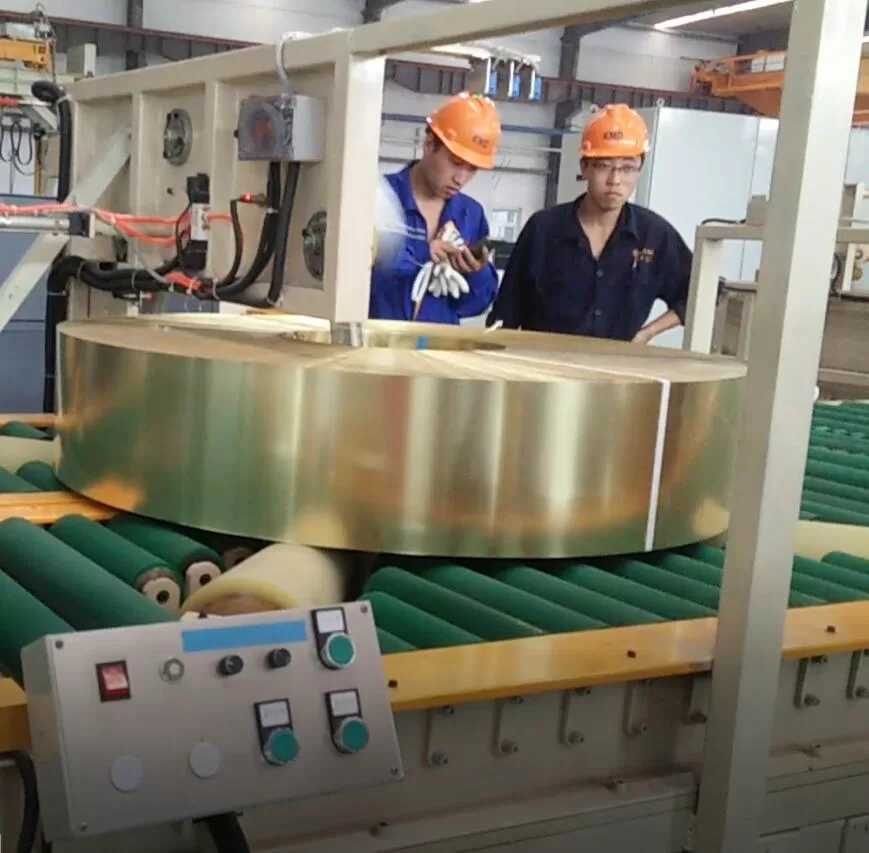As a plant manager in Mexico's demanding metal industry, you are under constant pressure. You have to meet production targets, control costs, and ensure safety all at the same time. It feels like a difficult juggling act. The real headache, however, often happens at the end of the production line. Manual packing is slow. It creates a bottleneck that affects your entire operation. Every delay, every damaged coil, and every near-miss injury feels like a huge drain on your profits and a personal challenge. But what if you could change that bottleneck into a smooth, efficient, automated process? This is not just about buying a machine. It is about finding a total solution that can transform your end-of-line operations.
Before upgrading to coil packing automation, plant managers in Mexico must focus on four key areas. First, identify the specific production bottlenecks that automation can solve. Second, calculate the true cost of current manual processes, including safety risks. Third, determine the real ROI beyond the initial machine price. Finally, find a knowledgeable partner who provides a complete solution, not just a piece of equipment.

I understand these challenges because I have lived them. Before I started SHJLPACK, I was an engineer on the factory floor. I saw these problems firsthand, from the slow pace of manual work to the very real danger it posed to my colleagues. My journey from an employee to a factory owner taught me valuable lessons. I want to share those lessons with you. Let’s break down each of these important points. This will help you make the best decision for your plant and your team.
How Can Automation Solve Your Biggest Production Bottlenecks?
Your production line runs smoothly, but then everything stops at the packing station. Steel coils or wire coils are piling up. They are waiting for workers to wrap and strap them by hand. This slowdown is more than just frustrating. It directly impacts your delivery schedules. It also limits your ability to take on new orders. You are producing materials at high speed, only to be held back by an old, manual process at the very end. A well-designed automated packing line does more than just speed up the wrapping. It syncs with your production output. It gets rid of the pile-up and creates a continuous, predictable flow from production to shipping.
Automation solves production bottlenecks by replacing slow, inconsistent manual labor with a high-speed, continuous, and reliable system. This includes automated coil loading, wrapping, strapping, and stacking. These steps drastically increase throughput. They also align your packaging capacity with your production speed, creating a much smoother operation.

From Manual Chaos to Automated Flow
The difference between a manual and an automated end-of-line process is night and day. In a manual setup, everything depends on human speed and strength. Workers might use a crane to lift a coil, place it on a pallet, then walk around it with a roll of stretch film. Then, they use a manual tool to apply straps. Every step is slow and variable. If a worker is tired or a new person is on the job, the whole process slows down. This creates inconsistency and a major bottleneck.
I remember this from my early days as an engineer. We had two strong guys who could barely keep up with the output from one slitting line. They were always rushing, and mistakes happened. Coils would get stacked improperly, or the wrapping would be too loose.
An automated line changes everything. A conveyor brings the coil directly from the slitter to the packing station. An automated eyelet wrapper applies film perfectly every time, in seconds. An automatic strapping machine applies and seals the straps at precise intervals. Then, a stacker or another conveyor moves the finished coil away, ready for shipping. The process becomes a smooth, continuous flow. One operator can oversee the entire process, ensuring quality without the physical strain.
| Feature | Manual Process | Automated Process |
|---|---|---|
| Coil Transport | Crane or forklift, high risk | Integrated conveyor system, low risk |
| Wrapping Speed | 5-10 minutes per coil | 1-2 minutes per coil |
| Consistency | Varies by worker and fatigue | Identical, high-quality wrap every time |
| Labor Requirement | 2-3 workers per station | 1 operator for the whole line |
| Safety | High risk of strain and injury | Minimal manual handling, very safe |
Identifying Your True Bottleneck
To get the most out of automation, you need to know exactly where your biggest problem is. Is the wrapping itself too slow? Or is the bottleneck the time it takes to get coils from the production line to the packing area? Maybe stacking the finished coils is what holds everything up. A good partner will help you analyze your specific workflow.
- If Transport is the Issue: An integrated system of conveyors and turntables can be the solution. This eliminates the need for a forklift or crane to move each coil, saving minutes on every cycle.
- If Wrapping is the Issue: A high-speed orbital wrapping machine is the core of the solution. These machines can wrap a coil much faster and more consistently than any human.
- If Strapping is the Issue: An automatic strapping machine can apply radial or eye-through straps without any manual intervention.
- If Stacking is the Issue: An automated stacking system can take the packaged coils and stack them neatly on a pallet, ready for the warehouse.
The key is that you don't need a one-size-fits-all solution. A modern packaging line is modular. You can build a system that solves your specific bottleneck, ensuring the best return on your investment.
What's the Real Cost of Ignoring Workplace Safety in Coil Handling?
Every day, you see your team manually handling heavy steel coils. You see them flipping pallets and moving heavy materials around the factory floor. It seems like a normal part of the job in a heavy-duty environment. But you also know the constant risk that comes with this work. A slip can lead to a serious back injury. A moment of inattention can result in crushed fingers or feet. The direct costs of an accident, like medical bills and workers' compensation, are huge. But the indirect costs are even more damaging. These include high insurance premiums, lost productivity during investigations, and high employee turnover. These hidden costs are a silent killer of your factory's profitability. Investing in automated handling solutions, like coil tilters and conveyor systems, is not just a safety measure. It is a strategic business decision that protects your most valuable asset—your people—and your bottom line.
The real cost of ignoring workplace safety in coil handling goes far beyond an employee's medical bills. It includes higher insurance premiums for your entire facility, lost production time, the high cost of hiring and training new employees to replace injured ones, and potential legal fees. All these factors slowly eat away at your factory's profit and stability.

The Hidden Financial Drain of Manual Handling
Many managers only look at the direct costs of an injury because they are easy to see on a spreadsheet. But the indirect costs are often four to ten times greater. When I was running my own factory, we had a close call where a worker nearly dropped a small coil on his foot. Nothing happened, but it made me stop and think. What if he had been seriously injured? The whole line would have stopped. We would have had an investigation. The team's morale would have dropped. And our insurance company would have definitely taken notice.
Let's break down these costs so they are clear.
| Cost Type | Examples | Financial Impact |
|---|---|---|
| Direct Costs | Medical expenses, compensation payments, emergency services. | Immediately visible, can be very high for a single incident. |
| Indirect Costs | - Production downtime during the incident and investigation. - Cost of hiring and training a replacement worker. - Increased insurance premiums for the next several years. - Time spent by management on incident reports and follow-up. - Damage to equipment or product during the incident. - Lower employee morale, leading to lower productivity. |
Often much larger than direct costs over time, but harder to track. This is where profits quietly disappear. |
Think about employee turnover. The metal industry is tough work. If your employees feel unsafe, they will leave for a better job. The cost to recruit, hire, and train a new employee can be thousands of dollars. An automated system makes the job safer and easier, making your factory a more attractive place to work.
How Automation Directly Mitigates Risk
Automation is the most effective way to engineer safety into your process. It removes the human from the most dangerous tasks.
- Coil Upenders/Tilters: Manually flipping a heavy coil from a horizontal to a vertical position is one of the most dangerous jobs on the floor. It puts immense strain on a worker's back. An automated coil tilter does this job in a controlled, safe motion in seconds. There is zero physical strain on the operator.
- Conveyor Systems: Relying on forklifts to move coils creates a lot of traffic and potential for accidents in a busy plant. An integrated conveyor system creates a dedicated, predictable path for materials. This reduces floor traffic and eliminates the risk of collisions or dropped loads.
- Wrapping and Strapping Machines: A worker walking backward around a pallet with a heavy roll of film is at risk of tripping and falling. A manual strapping tool can also create repetitive motion injuries. An automated machine contains these processes within a safe, guarded area. The operator simply pushes a button from a safe distance.
By automating these key steps, you are not just preventing accidents. You are building a fundamentally safer workplace. This leads to a more confident, stable, and productive workforce.
How Do You Calculate the True ROI of a Coil Packing Machine?
You receive a quote for a new automated packing line, and the price tag seems high. It is a significant capital investment for your plant. It is easy to get "sticker shock" and only compare that number to your current labor costs for packing. But this narrow view is a mistake. It ignores the massive hidden costs of your current manual process. It also ignores the full financial benefits that automation brings. If you only look at the purchase price, you risk making a decision based on incomplete information. A proper Return on Investment (ROI) calculation goes much deeper. It must account for labor savings, reduced product damage, lower consumption of wrapping materials, and increased throughput. When you see the full picture, you will find that the right machine pays for itself much faster than you think.
To calculate the true ROI of a coil packing machine, you must look beyond the initial purchase price. You need to factor in all the savings you will gain. This includes savings from reduced labor, fewer product damage claims, lower consumption of wrapping film and straps, increased production output because the bottleneck is gone, and improved workplace safety, which leads to lower insurance costs.

Beyond the Price Tag: A Total Cost of Ownership (TCO) Approach
A smart manager doesn't just think about the purchase price. They think about the Total Cost of Ownership (TCO). This includes the initial cost, but also all the costs of running the machine over its life. It also includes all the savings the machine will generate.
TCO = Initial Investment + Lifetime Operating Costs - Lifetime Savings
Let's break this down:
- Initial Investment: This is the price of the machine, plus costs for shipping, installation, and initial training for your team.
- Operating Costs: This includes electricity, compressed air, spare parts, and regular maintenance. A good supplier will be transparent about these costs.
- Lifetime Savings: This is the most important part of the calculation and where the real value is. It includes all the money you will stop spending because you have the new machine. This includes wages for manual packers, the cost of wasted wrapping film, the cost of coils that get damaged during handling, and the high cost of workplace accidents.
When you compare two machines, the one with the lower price might actually have a higher TCO if it's inefficient, unreliable, or uses more wrapping material. I learned this the hard way. Early in my career, I recommended a cheaper machine to my boss. It saved us money upfront, but it broke down constantly and the wrapping it produced was poor. The TCO was a disaster.
A Simple Framework for Your ROI Calculation
Let's make this practical. You can use this simple table to start estimating your own ROI. Use your own factory's numbers for the best results.
| Category | Calculation Details | Your Estimated Annual Figure ($) |
|---|---|---|
| A. Annual Savings | ||
| Labor Savings | (Number of workers moved) x (Annual salary + benefits) | |
| Material Savings | (Current annual film cost) x (% reduction from machine pre-stretch) | |
| Product Damage Reduction | (Number of damaged coils per year) x (Value per coil) x (% reduction) | |
| Safety & Insurance Savings | (Annual insurance premium) x (% estimated reduction) + (Cost of one minor incident) | |
| Total Annual Savings (A) | Sum of the above | |
| B. Annual Gains | ||
| Increased Throughput | (Extra coils packed per day) x (Profit per coil) x (Working days per year) | |
| Total Annual Gains (B) | ||
| C. Initial Investment | ||
| Machine Cost | Price from supplier | |
| Installation & Training | Quote for installation and training | |
| Total Investment (C) | Sum of the above | |
| Return on Investment | ( (A + B) / C ) x 100% = ROI % | |
| Payback Period (Years) | C / (A + B) |
This exercise will give you a powerful tool to show your management team. It changes the conversation from "This machine is expensive" to "This machine will pay for itself in 18 months and increase our profits."
Why is a 'Partner' Better Than a 'Supplier' for Your Automation Project?
You have probably dealt with equipment suppliers before. They make big promises during the sales pitch. They show you impressive videos and brochures. But once the machine is installed and they have your money, they seem to disappear. The salesperson stops answering your calls. This leaves you and your team struggling with a machine that doesn't quite fit your process. You have no expert to call for help when there's a problem. Many managers, maybe even you, have been burned by this "sell and run" approach. Because of this, you are understandably careful about finding a new vendor. Now, imagine working with someone who has been in your shoes. Someone who understands the pressures of running a factory. Someone whose main goal is to see your business succeed. This is the difference between a simple supplier and a true partner.
A partner is better than a supplier because a partner offers a total solution, not just a product. A partner invests time to understand your unique challenges, production flow, and business goals. They provide expert guidance based on real-world manufacturing experience. And most importantly, they offer strong after-sales support to ensure your long-term success and growth.

The Supplier Mindset vs. The Partner Mindset
The difference in approach is fundamental. It affects every part of your experience, from the first conversation to the support you receive years later. Recognizing this difference is key to avoiding the frustration you've felt in the past.
| Aspect | The Supplier Mindset | The Partner Mindset |
|---|---|---|
| Main Goal | To make a one-time sale. | To build a long-term relationship. |
| Focus | Sells machine features ("Our machine runs at X speed"). | Solves your specific problems ("Let's solve your bottleneck issue"). |
| Process | Sends a standard quote. | Asks many questions to understand your needs first. |
| Solution | Offers a standard, off-the-shelf machine. | Customizes the solution to fit your unique layout and products. |
| Job Completion | The job is done when the machine is delivered. | The job is only done when you are achieving your goals. |
| After-Sales | Support is slow, may cost extra. | Support is a core part of the offer, focused on your uptime. |
I decided early on that SHJLPACK would operate with a partner mindset. Why? Because when I was running my own factory, the suppliers who treated me like a partner were the ones who truly helped my business grow. The ones who just sold me a box were the ones who caused me headaches. A machine is a tool, but the expertise and support behind that tool are what create real value.
What to Look For in a True Partner
So, how can you tell if you are talking to a partner or just a supplier? Here are some key things to look for and questions to ask.
- Deep Industry Experience: Don't just ask how long the company has been in business. Ask about the personal background of the engineers and the owner. Have they ever worked on a factory floor? Do they understand the pressures of production schedules and maintenance?
- A Consultative Approach: A partner will ask more questions than you do. They will want to know about your product flow, your building layout, your specific coil sizes, and your biggest frustrations. If they start by pitching a machine without understanding your problem, that is a red flag.
- Customization Capabilities: Your factory is unique. A true partner won't try to force a standard machine into your space. They will show you how they can customize the conveyor layout, the machine height, or the software to perfectly integrate with your existing operations.
- Transparency: Ask them about the "bad stuff." What are the common maintenance needs? How much do spare parts cost? Where are they located? A partner will be honest and upfront about the total cost of ownership.
- Strong After-Sales Support: This is critical. Ask them detailed questions about their support structure. Who do you call when there is a problem? What is their response time? Do they offer remote diagnostics? Do they provide comprehensive training for your operators and maintenance staff?
This is why I put my personal story on our website. I want clients to know they are not dealing with a faceless corporation. They are dealing with Vincent Liu, an engineer who built his own factory and is now dedicated to helping others do the same. My mission is not just to sell wrapping machines. It is to provide the total solution that I wish I had when I was in your position.
My Final Thoughts: From Engineer to Your Partner
My journey in this industry didn't start in a sales office. It started on the factory floor, with grease on my hands, as a packing machine engineer. I saw the daily struggles: the production lines backing up, the frustration of workers trying to wrap heavy coils by hand, and the cost of damaged goods.
Later, when I built my own packing machine factory, I faced the same challenges you do now, but from the manager's chair. I felt the pressure of payroll, the need for efficiency, and the responsibility for my team's safety. It was by solving these exact problems—automating our processes, focusing on real ROI, and improving safety—that my factory became successful and I achieved financial independence.
I am grateful for what this industry has given me. That is why I founded SHJLPACK with a different mission. We are not just a company that sells machines. We are a knowledge-sharing platform. My goal is to give back, to share the expertise and insights I learned on my journey. I want to be the partner I wish I had when I was starting out—someone who understands the whole picture, from the engineering details to the business goals. When you succeed, we succeed.
Conclusion
Investing in automation is a major decision. By focusing on your specific bottlenecks, the true cost of safety, a comprehensive ROI, and finding a real partner, you can ensure a successful and profitable future for your plant.





